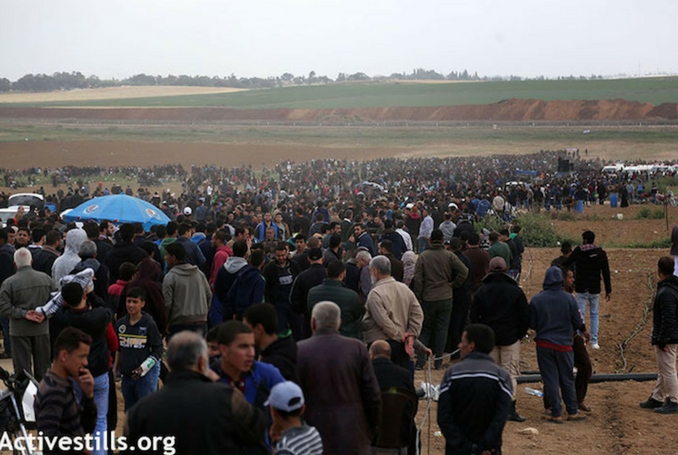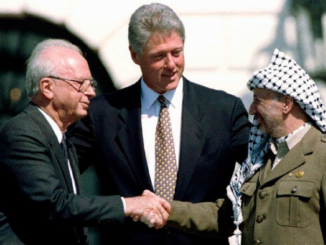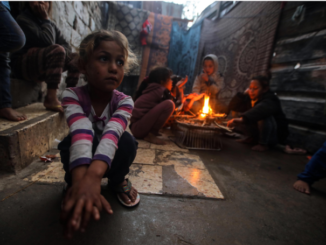
By Denijal Jegić
Fear has consistently shaped Zionism’s approach towards the indigenous Palestinians. As Palestinians have been blamed for merely standing in the way of the colonizer, their removal which has entailed multidimensional policies of ethnic cleansing and genocide, has been rhetorically rationalized through Orientalist transformations of Palestinians from the original owners of the land into “Islamist” terrorists. While Palestinians face a multitude of structural and physical violence, reoccurring culminations of Israeli aggressions resulting in the mass production of Palestinian death have repeatedly highlighted the always-already dehumanized position of Palestinians in the Western political and public sphere.
The Great Return March, a popular, peaceful protest of Palestinian refugees in Gaza, discloses once again that Palestinians are being blamed for their very existence by Israel and its allies. The protest is a colonized population’s call for the implementation of international law. Gazans are collectively incarcerated, besieged at land, air, and water, denied the right to return – a right that was granted in UN Resolution 194 in 1948 – for seven decades, while simultaneously facing a tremendous humanitarian catastrophe that entails the lack of food, water, and electricity. Reduced to bare existence, Israel regularly bombards them – like in the 2014 war – and tests new weapons on their bodies.
It was not surprising that this time again Israel’s advanced military immediately attacked the protesters. Audio-visual material shared on social media by Palestinians shows how Israeli snipers indiscriminately shot anyone who came near Israel’s “border fence.” This banal violence that resulted in a massacre of Palestinians was encouraged by the Israeli government, largely ignored by Western governments, and legitimized by Western media.
Major news outlets euphemized Israeli aggression as passive response, linguistically appealing to the readers’ implicit Orientalism and rationalizing the use of military aggression against peaceful protesters. For example, the Washington Post wrote about “deadly clashes” (March 30) and CNN narrated that Palestinians were “killed in confrontations with Israeli forces” (March 31). According to a New York Times article (March 30), which merely paraphrased the Israeli narrative, “the Israelis responded.” The same article concludes by retrospectively justifying Israel’s three wars on Gaza as a combat against “the threat posed by rockets fired by Hamas and other militant groups, and from tunnels crossing under the border.” Fox News blamed “Gaza attacks” on Hamas. Most reports included pictures of Kuffiye-wearing Palestinians throwing stones. Pictures and videos of heavily armed Israeli soldiers, or of the shootings of unarmed Palestinian civilians – though omnipresent on social media – were omitted.
This fantasy of “clashes” and “confrontations” projects a conflict between two independent countries. Like the Israeli government, media deprives Palestinians of their geo-political and historical context, suggests a parity of power between colonizer and colonized, and implies that Palestinians simply die because they have to, not because they are massacred.
This is also Israel’s standard rhetoric. A cable sent out by Israel’s Foreign Ministry to Israeli diplomats outlines the simple copy-paste tactic the Israeli government has perpetually employed to justify any new killings of Palestinians: as usual, the protest is demonized as “dangerous,” “premeditated,” and a “Hamas-led confrontation campaign.” All Palestinians are rhetorically transformed into terrorists fighting for Hamas, which is depicted as the world’s most dangerous terror organization capable of rapidly destroying Israel. Hence, all violence against Palestinians is necessary self-defense. Concurrently, Palestinians are blamed for their own death – like in 2014, when Naftali Bennett blamed Hamas for a Palestinian “self-genocide.”
Following the narrative behind this widespread criminalization of Palestinian dissent, Palestinians would not protest because of unsustainable living conditions, because of the omnipresence of death, or because they are facing a brutal military occupation – but because they simply hate for no reason. These Orientalist assumptions suggest that Palestinians do not have any agency.
The Anti-Defamation League (ADL) defined the protests “a call for the end of the state of Israel.” The ADL is right. Palestinian demands, i.e. the implementation of international law, an end of the occupation, and the granting of human rights, would certainly lead to an end of Israel in its current forms. Indeed, Israel is based on settler-colonialism, occupation, apartheid, ethnocracy, ethnic cleansing, and genocidal policies, all of which presuppose the perpetuation of Orientalist, Eurocentric, and Islamophobic racialization and dehumanization of Palestinians, who remain simultaneously unknowable and imagined as violent. Palestinians are seen as guilty for not surrendering and for drawing worldwide attention to their struggle. Hence, they are blamed for their very human survival instinct and for not embracing their own death.
Media narratives reveal that Palestinians are comprehended as a plague. If the Israeli military’s shooting of an unarmed protester is considered a “clash,” then the danger stemming from Israeli weapons is on par with the danger coming from an unarmed Palestinian. Thus, Palestinians do not need to take weapons in order to be understood as dangerous. Their existence is comprehended as an attack per se, and the visibility of that existence continues to haunt the Zionist colonial project, as Israel continues trying to make Palestinians disappear discursively and physically.
– Denijal Jegić is a doctoral researcher in Transnational American Studies. He contributed this article to The Palestine Chronicle. Follow him on Twitter: @denijeg








The irony in the IDF using a toxic gas to scare away the Palestinians, then shooting the ones that don’t move fast enough seems to be lost on the MSM.